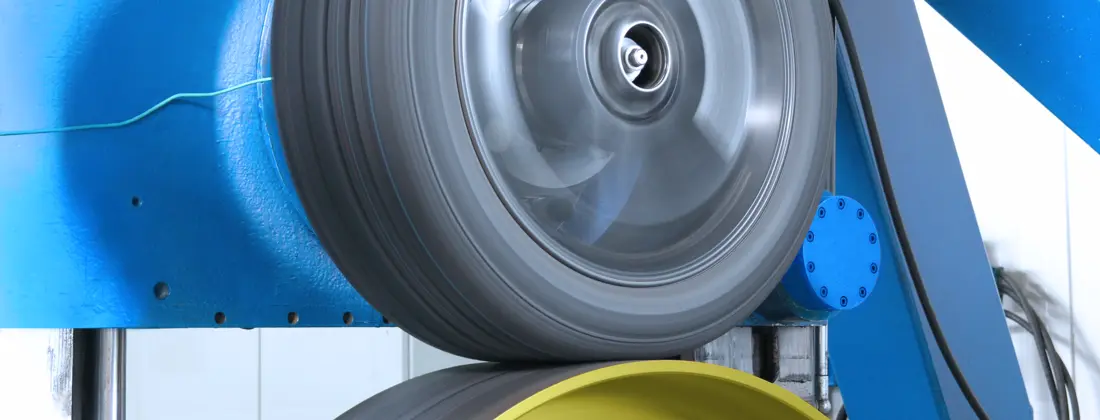ISO 23671 Wet Grip Braking Tyre Test
The ISO 23671 wet grip braking test is a pivotal component in the development and certification of tyres, focusing on safety performance under wet road conditions. This standard evaluates how effectively a tyre can stop on wet surfaces, which is crucial for ensuring driver safety and minimizing accidents during inclement weather.
The test involves subjecting tyres to specific conditions that simulate real-world driving scenarios. The procedure requires the tyre to be mounted on a wheel and driven at various speeds over a braking track where water depth is controlled to represent wet road conditions. The key performance metric measured in this test is the deceleration rate, which indicates how quickly the tyre can bring the vehicle to a halt.
The ISO 23671 standard emphasizes the importance of reducing non-tread rubber contact with the road surface. This ensures that more water is displaced by the tread pattern, enhancing braking efficiency on wet roads. The test also evaluates the tyre's hydroplaning resistance and its ability to maintain directional stability under these conditions.
The testing apparatus typically includes a sophisticated braking track equipped with sensors capable of measuring deceleration rates accurately. Additionally, environmental factors such as temperature, humidity, and road surface texture play significant roles in influencing test outcomes. These parameters are meticulously controlled to ensure that the results are representative of real-world conditions.
Compliance with ISO 23671 is essential for tyre manufacturers aiming to meet stringent safety standards set by regulatory bodies worldwide. By adhering to this standard, tyre makers can demonstrate their commitment to producing safe and reliable products. The test results provide critical data that helps in the continuous improvement of tyre designs.
For quality managers and compliance officers, understanding the nuances of ISO 23671 is indispensable. It ensures that tyres meet international safety standards, which is crucial for maintaining a good reputation among consumers and regulatory bodies alike. For R&D engineers, this test offers valuable insights into tyre performance under wet conditions, enabling them to innovate and improve product designs.
In the procurement process, ISO 23671 compliance can be a deciding factor in selecting suppliers. By ensuring that tyres meet this standard, companies can guarantee consistent quality across their supply chains. This reliability is particularly important for automotive manufacturers who prioritize safety and performance in their products.
Benefits
The ISO 23671 wet grip braking test offers numerous benefits to tyre manufacturers, quality managers, compliance officers, R&D engineers, and procurement teams. By complying with this standard, tyre manufacturers can:
- Enhance safety on wet roads.
- Meet international safety standards set by regulatory bodies.
- Demonstrate commitment to producing safe and reliable products.
- Provide valuable data for continuous improvement of tyre designs.
- Increase consumer confidence in their brand.
- Ensure consistent quality across supply chains.
International Acceptance and Recognition
The ISO 23671 wet grip braking test is widely accepted and recognized by numerous countries and regulatory bodies around the world. This international recognition underscores its importance in ensuring tyre safety on wet roads.
Many countries have implemented regulations mandating compliance with this standard for tyres to be sold within their borders. For example, the European Union requires all new tyres intended for sale to comply with ISO 23671. The United States also has similar requirements for imported tyres, ensuring that they meet stringent safety standards.
The acceptance of this test is not limited to automotive tyres; it extends to other tyre types such as motorcycles, bicycles, and agricultural machinery tyres. This broad applicability ensures a consistent approach to tyre safety globally. Compliance with ISO 23671 is thus a global standard that helps maintain the highest levels of road safety.
Environmental and Sustainability Contributions
- The ISO 23671 test promotes sustainable tyre design by encouraging manufacturers to use materials and structures that enhance wet grip performance. This reduces the environmental impact of tyres, as more efficient tyres can lead to lower fuel consumption.
- Improved braking on wet roads translates to fewer accidents, which in turn leads to reduced traffic congestion and associated emissions from emergency braking scenarios.
- The test also supports recycling efforts by ensuring that tyre materials are optimized for performance, thus extending their useful life cycle. This reduces the amount of waste sent to landfills.





